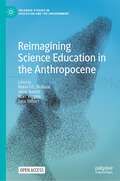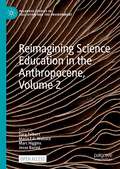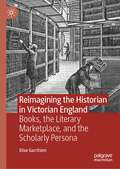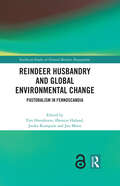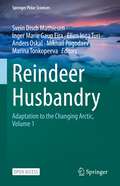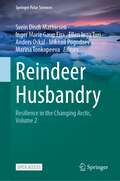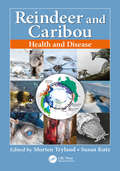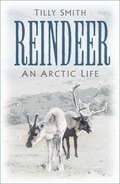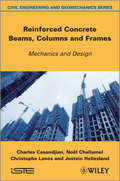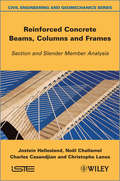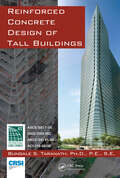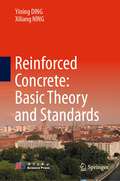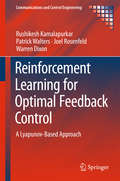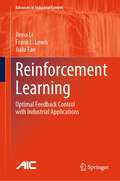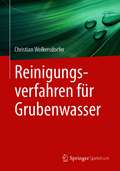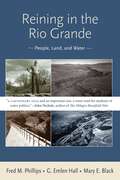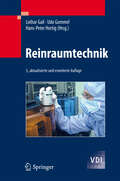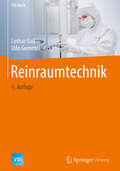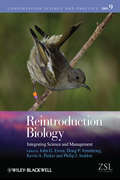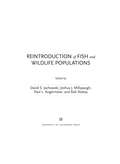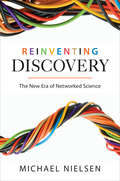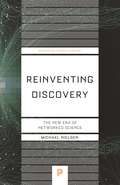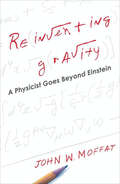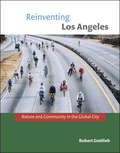- Table View
- List View
Reimagining Science Education in the Anthropocene (Palgrave Studies in Education and the Environment)
by Jesse Bazzul Marc Higgins Maria F. G. Wallace Sara TolbertThis open access edited volume invites transdisciplinary scholars to re-vision science education in the era of the Anthropocene. The collection assembles the works of educators from many walks of life and areas of practice together to help reorient science education toward the problems and peculiarities associated with the geologic times many call the Anthropocene. It has become evident that science education—the way it is currently institutionalized in various forms of school science, government policy, classroom practice, educational research, and public/private research laboratories—is ill-equipped and ill-conceived to deal with the expansive and urgent contexts of the Anthropocene. Paying homage to myopic knowledge systems, rigid state education directives, and academic-professional communities intent on reproducing the same practices, knowledges, and relationships that have endangered our shared world and shared presents/presence is misdirected. This volume brings together diverse scholars to reimagine the field in times of precarity.
Reimagining Science Education in the Anthropocene, Volume 2 (Palgrave Studies in Education and the Environment)
by Jesse Bazzul Marc Higgins Maria F. G. Wallace Sara TolbertThis volume, a follow up to Reimagining Science Education in the Anthropocene (2021), continues a transdisciplinary conversation around reconceptualizing science education in the era of the Anthropocene. Drawing educators from many walks of life and areas of practice together in a creative work that helps reorient science education toward the problems and peculiarities associated with this contemporary geologic time. This work continues the mission of transforming the ways communities inherit science and technology education: its knowledges, practices, policies, and ways-of-living-with-Nature. Our understanding of the Anthropocene is necessarily open and pluralistic, as different beings on our planet experience this time of crisis in different ways. This second volume continues to nurture productive relationships between science education and fields such as science studies, environmental studies, philosophy, the natural sciences, Indigenous studies, and critical theory in order to provoke a science education that actively seeks to remake our shared ecological and social spaces in the coming decades and centuries. This is an open access book.
Reimagining the Historian in Victorian England: Books, the Literary Marketplace, and the Scholarly Persona
by Elise GarritzenThis book traces the transformation of history from a Romantic literary pursuit into a modern academic discipline during the second half of the nineteenth century, and shows how this change inspired Victorians to reconsider what it meant to be a historian. This reconceptualization of the ‘historian’ lies at the heart of this book as it explores how historians strove to forge themselves a collective scholarly persona that reflected and legitimised their new disciplinary status and gave them authority to speak on behalf of the past. The author argues that historians used the persona as a replacement for missing institutional structures, and converted book parts to a sphere where they could mould and perform their persona. By ascribing agency to titles, footnotes, running heads, typography, cover design, size, and other paratexts, the book makes an important shift in the way we perceive the formation of modern disciplines. By combining the persona and paratexts, it offers a novel approach to themes that have enjoyed great interest in the history of science. It examines, for example, the role which epistemic and moral virtues held in the Victorian society and scholarly culture, the social organization and hierarchies of scholarly communities, the management of scholarly reputations, the commercialization of knowledge, and the relationship between the persona and the underpinning social, political, economic, and cultural structures and hierarchies. Making a significant contribution to persona studies, it provides new insights for scholars interested in the history of humanities, science, and knowledge; book history; and Victorian culture.
Reindeer Hunters of the Ice Age in Europe: Economy, Ecology, and the Annual Nomadic Cycle
by Laure FontanaThis book undertakes a thorough study of Reindeer in the Upper Pleniglacial and Tardiglacial societies in France. It addresses two main topics – the economy of animal resources within the societies and the exploitation of Reindeer organized within the annual cycle, in terms of space and time, between 30,000 and 14,000 cal BP in France. The author proposes an analysis and hypothesis regarding the economy of animal resources and the nomadic cycle of the last Paleolithic hunter-gatherer societies, in order to identify a “Reindeer system.”The author discusses the relationship between Reindeer and human mobility and offers some conclusions regarding the annual cycles of nomadism. The volume scrutinizes the distinct eco systems in three regions and its effects on the movements of both human and animal. This book is of interest to zooarchaeologists and prehistorians.
Reindeer Husbandry and Global Environmental Change: Pastoralism in Fennoscandia (Earthscan Studies in Natural Resource Management)
by Tim HorstkotteThis volume offers a holistic understanding of the environmental and societal challenges that affect reindeer husbandry in Fennoscandia today. Reindeer husbandry is a livelihood with a long traditional heritage and cultural importance. Like many other pastoral societies, reindeer herders are confronted with significant challenges. Covering Norway, Sweden and Finland – three countries with many differences and similarities – this volume examines how reindeer husbandry is affected by and responds to global environmental change and resource extraction in boreal and arctic social-ecological systems. Beginning with an historical overview of reindeer husbandry, the volume analyses the realities of the present from different perspectives and disciplines. Genetics, behavioural ecology of reindeer, other forms of land use, pastoralists’ norms and knowledge, bio-economy and governance structures all set the stage for the complex internal and externally imposed dynamics within reindeer husbandry. In-depth analyses are devoted to particularly urgent challenges, such as land-use conflicts, climate change and predation, identified as having a high potential to shape the future pathways of the pastoral identity and productivity. These futures, with their risks and opportunities, are explored in the final section, offering a synthesis of the comparative approach between the three countries that runs as a recurring theme through the book. With its richness and depth, this volume contributes significantly to the understanding of the substantial impacts on pastoralist communities in northernmost Europe today, while highlighting viable pathways to maintaining reindeer husbandry for the future. This book will be of great interest to students and scholars of both the natural and social sciences who work on natural resource management, global environmental change, pastoralism, ecology, social-ecological systems, rangeland management and Indigenous studies.
Reindeer Husbandry: Adaptation to the Changing Arctic, Volume 1 (Springer Polar Sciences)
by Anders Oskal Svein Disch Mathiesen Inger Marie Gaup Eira Ellen Inga Turi Mikhail Pogodaev Marina TonkopeevaThis open access book focuses on climate change, Indigenous reindeer husbandry, and the underlying concept of connecting the traditional knowledge of Indigenous reindeer herders in the Arctic with the latest research findings of the world’s leading academics. The Arctic and sub-Arctic environment, climate, and biodiversity are changing in ways unprecedented in the long histories of the north, challenging traditional ways of life, well-being, and food security with legitimate concerns for the future of traditional Indigenous livelihoods. The book provides a clear and thorough overview of the potential problems caused by a warming climate on reindeer husbandry and how reindeer herders’ knowledge should be brought to action. In particular, the predicted impacts of global warming on winter climate and the resilience of the reindeer herding communities are thoroughly discussed.
Reindeer Husbandry: Resilience in the Changing Arctic, Volume 2 (Springer Polar Sciences)
by Anders Oskal Svein Disch Mathiesen Inger Marie Gaup Eira Ellen Inga Turi Mikhail Pogodaev Marina TonkopeevaThis open access book focuses on climate change, indigenous reindeer husbandry and the underlying concept of connecting the traditional knowledge of indigenous reindeer herders in the Arctic with the latest research findings of the world’s leading academics. The Arctic and sub-Arctic environment, climate and biodiversity are changing in ways unprecedented in the long histories of the north, challenging traditional ways of life, well-being, and food security with legitimate concerns for the future of traditional indigenous livelihoods. The book provides a clear and thorough overview of the potential problems caused by a warming climate on reindeer husbandry and how reindeer herders' knowledge should be brought to action. In particular, the predicted impacts of global warming on winter climate and the resilience reindeer of communities are thoroughly discussed.
Reindeer and Caribou: Health and Disease
by Morten Tryland Susan J. KutzThis book is a comprehensive presentation of health and diseases in reindeer and caribou, or just Rangifer, a key Circumarctic species with broad social and ecological value. It is an essential reference for anyone interested in the biology and health of wild or semi-domesticated reindeer and caribou, and is more broadly relevant for those with interests in other species of free-ranging and captive cervids. Beginning with a general introduction to Rangifer as a species, it then focuses on Rangifer "health" as a concept and describes the determinants of health at an individual and population level. Chapters cover a range of topics from nutrition and feeding to stress, non-infectious and infectious diseases, meat hygiene, capture and restraint, diagnosis and treatment of health issues, and finally, potential impacts of climate change on health of Rangifer. Reindeer and Caribou: Health and Disease compiles extensive research and experience-based information on issues ranging from drug doses for chemical immobilization, blood chemistry values, and raising an orphaned calf. In addition, it contains hundreds of high quality colour illustrations that contribute to its value as a diagnostic resource for recognizing various parasites, pathogens and signs of disease, both in live and dead animals. Each chapter is followed by a comprehensive list of references and a list of contact information for all the contributors, identifying world experts in the different areas of health for this circumpolar and fascinating species. This book is compulsory reading and an indispensable resource for anyone dealing with health in reindeer and caribou, including veterinarians, wildlife biologists and managers, reindeer herders/game ranchers, zoological husbandry personnel, and students with wildlife health.
Reindeer: An Arctic Life
by Tilly SmithIn this enchanting book, self-confessed reindeer geek Tilly Smith leads the reader through the extraordinary natural history of the reindeer with charming anecdotes about her own Scottish herd.From their flat ‘clown-like’ hooves to their warm furry noses and majestic antlers, fall in love with nature’s most adaptable arctic mammal.
Reinforced Concrete Beams, Columns and Frames: Mechanics and Design (Wiley-iste Ser.)
by Jostein Hellesland Charles Casandjian Christophe Lanos Noël ChallamelThis book is focused on the theoretical and practical design of reinforced concrete beams, columns and frame structures. It is based on an analytical approach of designing normal reinforced concrete structural elements that are compatible with most international design rules, including for instance the European design rules – Eurocode 2 – for reinforced concrete structures. The book tries to distinguish between what belongs to the structural design philosophy of such structural elements (related to strength of materials arguments) and what belongs to the design rule aspects associated with specific characteristic data (for the material or loading parameters). Reinforced Concrete Beams, Columns and Frames – Mechanics and Design deals with the fundamental aspects of the mechanics and design of reinforced concrete in general, both related to the Serviceability Limit State (SLS) and the Ultimate Limit State (ULS). A second book, entitled Reinforced Concrete Beams, Columns and Frames – Section and Slender Member Analysis, deals with more advanced ULS aspects, along with instability and second-order analysis aspects. Some recent research results including the use of non-local mechanics are also presented. This book is aimed at Masters-level students, engineers, researchers and teachers in the field of reinforced concrete design. Most of the books in this area are very practical or code-oriented, whereas this book is more theoretically based, using rigorous mathematics and mechanics tools. Contents 1. Design at Serviceability Limit State (SLS). 2. Verification at Serviceability Limit State (SLS). 3. Concepts for the Design at Ultimate Limit State (ULS). 4. Bending-Curvature at Ultimate Limit State (ULS). Appendix 1. Cardano’s Method. Appendix 2. Steel Reinforcement Table. About the Authors Charles Casandjian was formerly Associate Professor at INSA (French National Institute of Applied Sciences), Rennes, France and the chairman of the course on reinforced concrete design. He has published work on the mechanics of concrete and is also involved in creating a web experience for teaching reinforced concrete design – BA-CORTEX. Noël Challamel is Professor in Civil Engineering at UBS, University of South Brittany in France and chairman of the EMI-ASCE Stability committee. His contributions mainly concern the dynamics, stability and inelastic behavior of structural components, with special emphasis on Continuum Damage Mechanics (more than 70 publications in International peer-reviewed journals). Christophe Lanos is Professor in Civil Engineering at the University of Rennes 1 in France. He has mainly published work on the mechanics of concrete, as well as other related subjects. He is also involved in creating a web experience for teaching reinforced concrete design – BA-CORTEX. Jostein Hellesland has been Professor of Structural Mechanics at the University of Oslo, Norway since January 1988. His contribution to the field of stability has been recognized and magnified by many high-quality papers in famous international journals such as Engineering Structures, Thin-Walled Structures, Journal of Constructional Steel Research and Journal of Structural Engineering.
Reinforced Concrete Beams, Columns and Frames: Section and Slender Member Analysis (Wiley-iste Ser.)
by Jostein Hellesland Charles Casandjian Christophe Lanos Noël ChallamelThis book is focused on the theoretical and practical design of reinforced concrete beams, columns and frame structures. It is based on an analytical approach of designing normal reinforced concrete structural elements that are compatible with most international design rules, including for instance the European design rules – Eurocode 2 – for reinforced concrete structures. The book tries to distinguish between what belongs to the structural design philosophy of such structural elements (related to strength of materials arguments) and what belongs to the design rule aspects associated with specific characteristic data (for the material or loading parameters). A previous book, entitled Reinforced Concrete Beams, Columns and Frames – Mechanics and Design, deals with the fundamental aspects of the mechanics and design of reinforced concrete in general, both related to the Serviceability Limit State (SLS) and the Ultimate Limit State (ULS), whereas the current book deals with more advanced ULS aspects, along with instability and second-order analysis aspects. Some recent research results including the use of non-local mechanics are also presented. This book is aimed at Masters-level students, engineers, researchers and teachers in the field of reinforced concrete design. Most of the books in this area are very practical or code-oriented, whereas this book is more theoretically based, using rigorous mathematics and mechanics tools. Contents 1. Advanced Design at Ultimate Limit State (ULS). 2. Slender Compression Members – Mechanics and Design. 3. Approximate Analysis Methods. Appendix 1. Cardano’s Method. Appendix 2. Steel Reinforcement Table. About the Authors Jostein Hellesland has been Professor of Structural Mechanics at the University of Oslo, Norway since January 1988. His contribution to the field of stability has been recognized and magnified by many high-quality papers in famous international journals such as Engineering Structures, Thin-Walled Structures, Journal of Constructional Steel Research and Journal of Structural Engineering. Noël Challamel is Professor in Civil Engineering at UBS, University of South Brittany in France and chairman of the EMI-ASCE Stability committee. His contributions mainly concern the dynamics, stability and inelastic behavior of structural components, with special emphasis on Continuum Damage Mechanics (more than 70 publications in International peer-reviewed journals). Charles Casandjian was formerly Associate Professor at INSA (French National Institute of Applied Sciences), Rennes, France and the chairman of the course on reinforced concrete design. He has published work on the mechanics of concrete and is also involved in creating a web experience for teaching reinforced concrete design – BA-CORTEX. Christophe Lanos is Professor in Civil Engineering at the University of Rennes 1 in France. He has mainly published work on the mechanics of concrete, as well as other related subjects. He is also involved in creating a web experience for teaching reinforced concrete design – BA-CORTEX.
Reinforced Concrete Design of Tall Buildings
by Bungale S. TaranathAn exploration of the world of concrete as it applies to the construction of buildings, Reinforced Concrete Design of Tall Buildings provides a practical perspective on all aspects of reinforced concrete used in the design of structures, with particular focus on tall and ultra-tall buildings. Written by Dr. Bungale S. Taranath, this work explains t
Reinforced Concrete: Basic Theory and Standards
by Yining DING Xiliang NINGThis book is intended to establish a bridge between the GB 50010, Fib MC2010, BS 8110 and ACI 318 or EC2. The respective pros and cons of different theories and methods according to various standards are compared or analyzed. Undergraduate and graduate students, foreign exchange students of international classes at Chinese universities who desire to work in China, or who are willing to work abroad in the field of civil engineering can benefit from the book. As such, this book provides valuable knowledge and useful design methods based on the different theories or guidelines.
Reinforcement Learning for Optimal Feedback Control: A Lyapunov-based Approach (Communications and Control Engineering)
by Patrick Walters Joel Rosenfeld Rushikesh Kamalapurkar Warren DixonReinforcement Learning for Optimal Feedback Control develops model-based and data-driven reinforcement learning methods for solving optimal control problems in nonlinear deterministic dynamical systems. In order to achieve learning under uncertainty, data-driven methods for identifying system models in real-time are also developed. The book illustrates the advantages gained from the use of a model and the use of previous experience in the form of recorded data through simulations and experiments. The book’s focus on deterministic systems allows for an in-depth Lyapunov-based analysis of the performance of the methods described during the learning phase and during execution. To yield an approximate optimal controller, the authors focus on theories and methods that fall under the umbrella of actor–critic methods for machine learning. They concentrate on establishing stability during the learning phase and the execution phase, and adaptive model-based and data-driven reinforcement learning, to assist readers in the learning process, which typically relies on instantaneous input-output measurements. This monograph provides academic researchers with backgrounds in diverse disciplines from aerospace engineering to computer science, who are interested in optimal reinforcement learning functional analysis and functional approximation theory, with a good introduction to the use of model-based methods. The thorough treatment of an advanced treatment to control will also interest practitioners working in the chemical-process and power-supply industry.
Reinforcement Learning: Optimal Feedback Control with Industrial Applications (Advances in Industrial Control)
by Frank L. Lewis Jialu Fan Jinna LiThis book offers a thorough introduction to the basics and scientific and technological innovations involved in the modern study of reinforcement-learning-based feedback control. The authors address a wide variety of systems including work on nonlinear, networked, multi-agent and multi-player systems. A concise description of classical reinforcement learning (RL), the basics of optimal control with dynamic programming and network control architectures, and a brief introduction to typical algorithms build the foundation for the remainder of the book. Extensive research on data-driven robust control for nonlinear systems with unknown dynamics and multi-player systems follows. Data-driven optimal control of networked single- and multi-player systems leads readers into the development of novel RL algorithms with increased learning efficiency. The book concludes with a treatment of how these RL algorithms can achieve optimal synchronization policies for multi-agent systems with unknown model parameters and how game RL can solve problems of optimal operation in various process industries. Illustrative numerical examples and complex process control applications emphasize the realistic usefulness of the algorithms discussed. The combination of practical algorithms, theoretical analysis and comprehensive examples presented in Reinforcement Learning will interest researchers and practitioners studying or using optimal and adaptive control, machine learning, artificial intelligence, and operations research, whether advancing the theory or applying it in mineral-process, chemical-process, power-supply or other industries.
Reinigungsverfahren für Grubenwasser
by Christian WolkersdorferDieses Buch begleitet Sie auf einer Reise, die bei den Grundlagen von Grubenwasser beginnt und Sie weiter über die korrekte Probenahme für eine Planung bis hin zu den aktiven und passiven Reinigungssystemen führt. In den jeweiligen Kapiteln erfahren Sie die wichtigsten Techniken über die zu messenden Parameter (z.B. Vor-Ort-Parameter, Durchfluss), welche Methoden es gibt, um Ihr Grubenwasser aktiv zu reinigen (z.B. Dickschlammmethode, Umkehrosmose, Ionenaustausch) und welche, um eine passive Reinigung (z.B. konstruierte Feuchtgebiete, Vertikaldurchflussreaktor, Carbonatkanal) durchzuführen. Auch bekommen Sie einen Einblick in die Nutzung von Grubenwasser. Erwarten Sie kein Kochbuch – vielmehr ist es eine Zutaten- und Utensilienliste, die Ihnen dabei hilft, das richtige Rezept zu finden. Eine erweiterte Hilfe dazu erhalten Sie durch die nahezu 1000 Referenzen zu allen vorgestellten Techniken. Ich habe dieses Buch für Hydrogeologen, Ingenieure, Graduierte in höheren Semestern, Behördenvertreter, Bergleute, Geoökologen, Chemieingenieure – im weitesten Sinne also für Sie geschrieben.
Reining in the Rio Grande: People, Land, and Water
by Fred M. Phillips G. Emlen Hall Black E. MaryThe Rio Grande was ancient long before the first humans reached its banks. These days, the highly regulated river looks nothing like it did to those early settlers. Alternately viewed as a valuable ecosystem and life-sustaining foundation of community welfare or a commodity to be engineered to yield maximum economic benefit, the Rio Grande has brought many advantages to those who live in its valley, but the benefits have come at a price.This study examines human interactions with the Rio Grande from prehistoric time to the present day and explores what possibilities remain for the desert river. From the perspectives of law, development, tradition, and geology, the authors weigh what has been gained and lost by reining in the Rio Grande.
Reinraumtechnik
by Hans-Peter Hortig Lothar Gail Udo GommelDer Band bietet eine fundierte Darstellung der Reinraumtechnik als branchenübergreifende Disziplin. Dabei verknüpfen die Autoren die Grundlagen der Reinraumtechnik mit deren Anwendungen und mit einer Anleitung zum selbständigen Erarbeiten von Problemlösungen. Für die 3. Auflage wurden Ergebnisse der nationalen und internationalen Reinraumkongresse ebenso berücksichtigt wie neue Regulierungen der Pharmazie, aktuelle Richtlinien und Anwendungen. Die Themen Hygienetechnik und Reinstwassertechnologie werden jetzt ausführlicher behandelt.
Reinraumtechnik (VDI-Buch)
by Lothar Gail Udo GommelDer Band bietet eine fundierte Darstellung der Reinraumtechnik als branchenübergreifende Disziplin. Dabei verknüpfen die Autoren die Grundlagen der Reinraumtechnik mit deren Anwendungen und mit einer Anleitung zum selbständigen Erarbeiten von Problemlösungen. Für die 3. Auflage wurden Ergebnisse der nationalen und internationalen Reinraumkongresse ebenso berücksichtigt wie neue Regulierungen der Pharmazie, aktuelle Richtlinien und Anwendungen. Die Themen Hygienetechnik und Reinstwassertechnologie werden jetzt ausführlicher behandelt.
Reintroduction Biology: Integrating Science and Management (Conservation Science and Practice #11)
by Doug P. Armstrong Philip J. Seddon Kevin A. Parker John G. EwenThis book aims to further advance the field of reintroduction biology beyond the considerable progress made since the formation of the IUCN/SSC Re-introduction Specialist Group. Using an issue-based framework that purposely avoids a structure based on case studies the book's central theme is advocating a strategic approach to reintroduction where all actions are guided by explicit theoretical frameworks based on clearly defined objectives. Issues covered include husbandry and intensive management, monitoring, and genetic and health management. Although taxonomically neutral there is a recognised dominance of bird and mammal studies that reflects the published research in this field. The structure and content are designed for use by people wanting to bridge the research-management gap, such as conservation managers wanting to expand their thinking about reintroduction-related decisions, or researchers who seek to make useful applied contributions to reintroduction.
Reintroduction of Fish and Wildlife Populations
by Joshua J. Millspaugh David S. Jachowski Rob Slotow Paul L. AngermeierReintroduction of Fish and Wildlife Populations provides a practical step-by-step guide to successfully planning, implementing, and evaluating the reestablishment of animal populations in former habitats or their introduction in new environments. In each chapter, experts in reintroduction biology outline a comprehensive synthesis of core concepts, issues, techniques, and perspectives. This manual and reference supports scientists and managers from fisheries and wildlife professions as they plan reintroductions, initiate releases of individuals, and manage restored populations over time. Covering a broad range of taxonomic groups, ecosystems, and global regions, this edited volume is an essential guide for academics, students, and professionals in natural resource management.
Reinventing Discovery: The New Era of Networked Science
by Michael NielsenIn Reinventing Discovery, Michael Nielsen argues that we are living at the dawn of the most dramatic change in science in more than 300 years. This change is being driven by powerful new cognitive tools, enabled by the internet, which are greatly accelerating scientific discovery. There are many books about how the internet is changing business or the workplace or government. But this is the first book about something much more fundamental: how the internet is transforming the nature of our collective intelligence and how we understand the world. Reinventing Discovery tells the exciting story of an unprecedented new era of networked science. We learn, for example, how mathematicians in the Polymath Project are spontaneously coming together to collaborate online, tackling and rapidly demolishing previously unsolved problems. We learn how 250,000 amateur astronomers are working together in a project called Galaxy Zoo to understand the large-scale structure of the Universe, and how they are making astonishing discoveries, including an entirely new kind of galaxy. These efforts are just a small part of the larger story told in this book--the story of how scientists are using the internet to dramatically expand our problem-solving ability and increase our combined brainpower. This is a book for anyone who wants to understand how the online world is revolutionizing scientific discovery today--and why the revolution is just beginning.
Reinventing Discovery: The New Era of Networked Science (Princeton Science Library #70)
by Michael NielsenHow the internet and powerful online tools are democratizing and accelerating scientific discoveryReinventing Discovery argues that we are living at the dawn of the most dramatic change in science in more than three hundred years. This change is being driven by powerful cognitive tools, enabled by the internet, which are greatly accelerating scientific discovery. There are many books about how the internet is changing business, the workplace, or government. But this is the first book about something much more fundamental: how the internet is transforming our collective intelligence and our understanding of the world. From the collaborative mathematicians of the Polymath Project to the amateur astronomers of Galaxy Zoo, Reinventing Discovery tells the exciting story of the unprecedented new era in networked science. It will interest anyone who wants to learn about how the online world is revolutionizing scientific discovery—and why the revolution is just beginning.
Reinventing Gravity: A Physicist Goes Beyond Einstein
by John W. MoffatEinstein's gravity theory—his general theory of relativity—has served as the basis for a series of astonishing cosmological discoveries. But what if, nonetheless, Einstein got it wrong?Since the 1930s, physicists have noticed an alarming discrepancy between the universe as we see it and the universe that Einstein's theory of relativity predicts. There just doesn't seem to be enough stuff out there for everything to hang together. Galaxies spin so fast that, based on the amount of visible matter in them, they ought to be flung to pieces, the same way a spinning yo-yo can break its string. Cosmologists tried to solve the problem by positing dark matter—a mysterious, invisible substance that surrounds galaxies, holding the visible matter in place—and particle physicists, attempting to identify the nature of the stuff, have undertaken a slew of experiments to detect it. So far, none have.Now, John W. Moffat, a physicist at the Perimeter Institute for Theoretical Physics in Waterloo, Canada, offers a different solution to the problem. The capstone to a storybook career—one that began with a correspondence with Einstein and a conversation with Niels Bohr—Moffat's modified gravity theory, or MOG, can model the movements of the universe without recourse to dark matter, and his work challenging the constancy of the speed of light raises a stark challenge to the usual models of the first half-million years of the universe's existence. This bold new work, presenting the entirety of Moffat's hypothesis to a general readership for the first time, promises to overturn everything we thought we knew about the origins and evolution of the universe.
Reinventing Los Angeles: Nature and Community in the Global City (Urban and Industrial Environments)
by Robert GottliebDescribes how water politics, cars and freeways, and immigration and globalization have shaped Los Angeles, and how innovative social movements are working to make a more livable and sustainable city.Los Angeles—the place without a sense of place, famous for sprawl and overdevelopment and defined by its car-clogged freeways—might seem inhospitable to ideas about connecting with nature and community. But in Reinventing Los Angeles, educator and activist Robert Gottlieb describes how imaginative and innovative social movements have coalesced around the issues of water development, cars and freeways, and land use, to create a more livable and sustainable city. Gottlieb traces the emergence of Los Angeles as a global city in the twentieth century and describes its continuing evolution today. He examines the powerful influences of immigration and economic globalization as they intersect with changes in the politics of water, transportation, and land use, and illustrates each of these core concerns with an account of grass roots and activist responses: efforts to reenvision the concrete-bound, fenced-off Los Angeles River as a natural resource; “Arroyofest,” the closing of the Pasadena Freeway for a Sunday of walking and bike riding; and immigrants' initiatives to create urban gardens and connect with their countries of origin. Reinventing Los Angeles is a unique blend of personal narrative (Gottlieb himself participated in several of the grass roots actions described in the book) and historical and theoretical discussion. It provides a road map for a new environmentalism of everyday life, demonstrating the opportunities for renewal in a global city.
